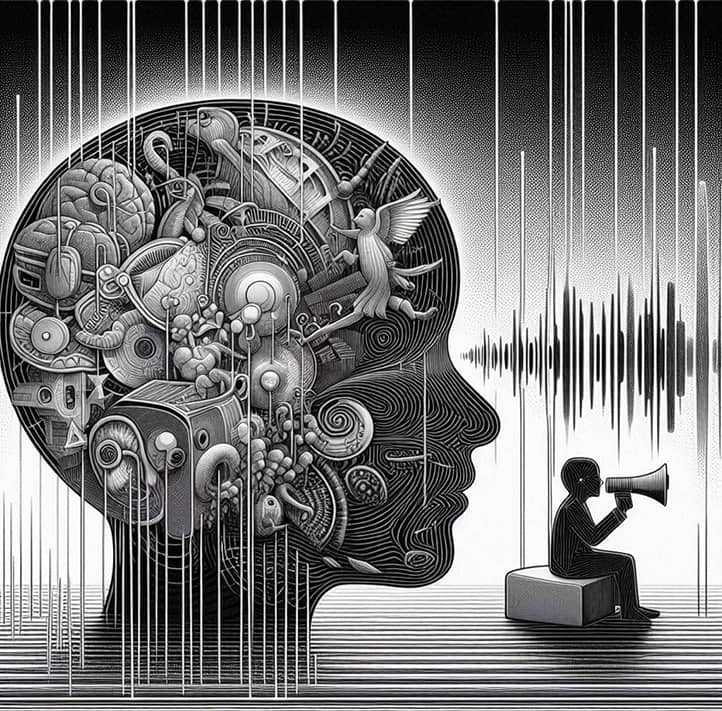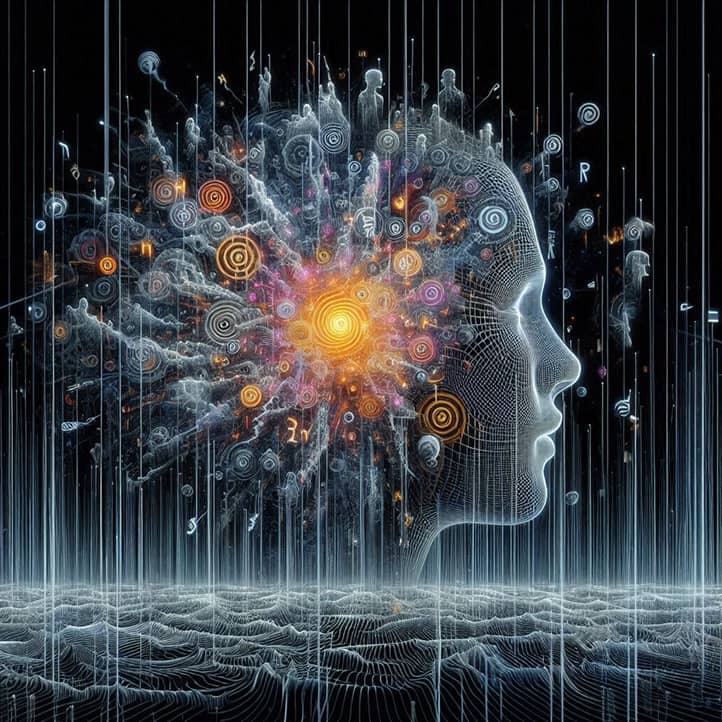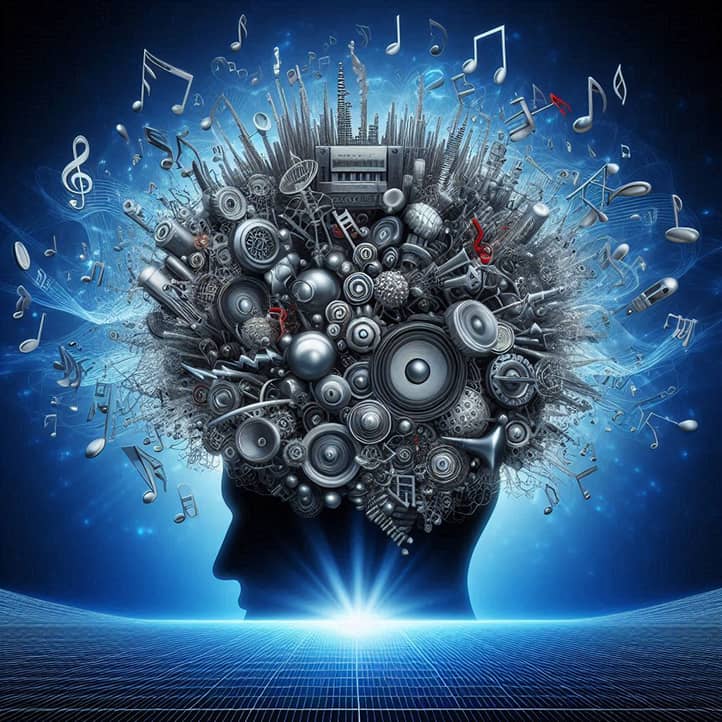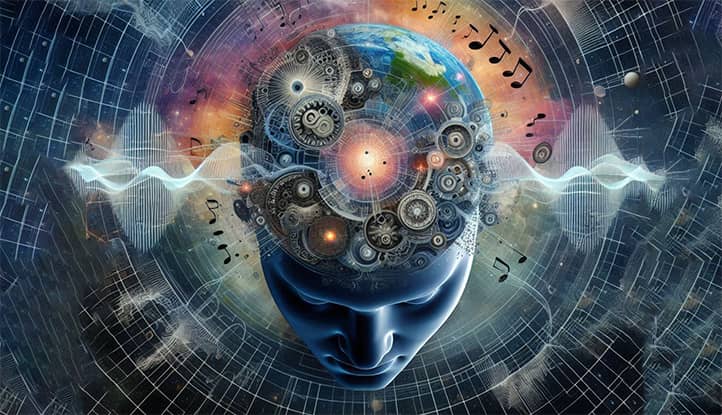Acoustic-mnestic aphasia is a complex speech function disorder that significantly affects the lives of patients and their loved ones. This type of aphasia is characterized by specific problems in speech perception and reproduction, making it unique among other forms of speech disorders.
Acoustic-mnestic aphasia is a form of speech disorder in which the patient experiences difficulties in understanding and remembering spoken speech, especially when perceiving long sentences or complex grammatical structures. This condition is often accompanied by problems with short-term memory and the ability to retain a sequence of sounds.
Key features of acoustic-mnestic aphasia include:
- Difficulties in perceiving long speech messages.
- Problems distinguishing similar speech sounds.
- Impairment of auditory-verbal memory.
- Difficulty repeating what has been heard.
- Challenges in understanding fast speech.
It is important to note that in acoustic-mnestic aphasia, the patient’s own speech may remain relatively intact, which distinguishes it from some other forms of aphasia.
The study of acoustic-mnestic aphasia began in the mid-20th century. A significant contribution to understanding this condition was made by Soviet neuropsychologists, particularly A.R. Luria. He described acoustic-mnestic aphasia as a separate form of speech disorder and linked it to damage to the middle sections of the temporal region of the left hemisphere of the brain.
Main stages in the study of acoustic-mnestic aphasia:
- 1940s: First descriptions of specific speech comprehension disorders associated with damage to the temporal lobes of the brain.
- 1950s: A.R. Luria’s work on the systematization of various forms of aphasia.
- 1960s-1970s: In-depth study of the neuroanatomical basis of acoustic-mnestic aphasia.
- 1980s-1990s: Development of neuroimaging methods, allowing for more precise localization of brain damage in aphasia.
- 2000s to the present: Research on neuroplasticity and the development of new rehabilitation methods.
Modern research on acoustic-mnestic aphasia continues to deepen our understanding of this condition, contributing to the development of more effective methods of diagnosis and treatment.

Causes of Acoustic-Mnestic Aphasia
Understanding the mechanisms underlying acoustic-mnestic aphasia is crucial for the development of effective diagnostic and treatment methods. Let’s examine the neuroanatomical basis and specific brain areas, the damage to which leads to the development of this condition.
Neuroanatomical Basis
Acoustic-mnestic aphasia arises as a result of dysfunction in certain areas of the brain responsible for processing and storing auditory information. The temporal lobe of the left hemisphere, especially its middle sections, plays a key role in this process.
This brain area is closely related to the processes of perceiving and analyzing speech sounds, as well as short-term memory. When these structures are damaged, the ability to retain a sequence of sounds in memory is disrupted, leading to the characteristic symptoms of acoustic-mnestic aphasia.
The main neuroanatomical structures involved in the processing of speech information include:
- Auditory cortex (Brodmann areas 41 and 42).
- Associative auditory cortex (Brodmann area 22).
- Wernicke’s area.
- Arcuate fasciculus (connecting Wernicke’s area with Broca’s area).
- Inferior parietal lobule.
- Hippocampus and related medial temporal lobe structures.
Dysfunction in these structures leads to specific problems in processing auditory information and its short-term storage, which is the key mechanism in the development of acoustic-mnestic aphasia.
Affected Brain Areas
The specific brain areas, the damage to which leads to the development of acoustic-mnestic aphasia, include:
- Middle sections of the temporal lobe of the left hemisphere.
- Wernicke’s area (posterior third of the superior temporal gyrus).
- Inferior parietal lobule.
Damage to these areas can be caused by various factors, such as:
- Stroke: Ischemic or hemorrhagic stroke in the middle cerebral artery basin, which supplies the temporal lobe.
- Traumatic brain injury: Brain contusion, intracranial hemorrhage.
- Brain tumors: Primary brain tumors or metastases.
- Neurodegenerative diseases: For example, early-stage Alzheimer’s disease.
- Infectious diseases: Encephalitis, meningitis affecting the temporal lobes.
- Demyelinating diseases: Multiple sclerosis with lesions in the temporal lobe.
It is important to note that the extent and localization of the damage may vary, leading to different severity of symptoms in different patients. Additionally, in some cases, acoustic-mnestic aphasia may coexist with other forms of aphasia, complicating the clinical picture and requiring careful differential diagnosis.
Modern neuroimaging methods, such as MRI and fMRI, allow for the precise localization of the affected area and assessment of the extent of functional connections between different brain regions. This is important not only for diagnosis but also for predicting disease progression and planning rehabilitation measures.

Acoustic-Mnestic Aphasia: Symptoms and Manifestations
Acoustic-mnestic aphasia is characterized by a specific set of symptoms, which may vary in severity among different patients. Understanding these manifestations is crucial for timely diagnosis and appropriate treatment.
Main Speech Impairments
In acoustic-mnestic aphasia, the following main speech impairments are observed:
- Difficulty understanding long sentences and complex grammatical constructions:
- Patients may easily understand short, simple sentences but have difficulty comprehending extended statements.
- The difficulty increases with the length and grammatical complexity of sentences.
- Problems with perceiving fast speech:
- Patients often ask their conversation partners to speak more slowly.
- Understanding can significantly improve when the speech tempo is slowed down.
- Difficulty repeating a heard sentence or sequence of words:
- Patients may correctly repeat individual words or short phrases but have difficulty with longer utterances.
- A phenomenon of “fading” is often observed: the patient can repeat the beginning of a sentence but “loses” its end.
- Impairment of the ability to retain a sequence of sounds in memory:
- Manifested in difficulties in remembering and reproducing a series of words or numbers.
- The volume of auditory-verbal memory is significantly reduced.
- Difficulty distinguishing similar-sounding phonemes:
- Patients may confuse words differing by one sound (e.g., “cat” and “cap”).
- This problem is especially noticeable in noisy environments or during fast speech.
- Problems with naming objects (anomia):
- Patients may have difficulty naming objects, especially those rarely used in daily life.
- The “tip-of-the-tongue” phenomenon, where the patient knows the word but cannot produce it, is frequently observed.
- Difficulty understanding figurative meanings, metaphors, and idioms:
- Patients tend to interpret speech literally, which complicates the understanding of humor and figurative expressions.
- Difficulty perceiving speech in noisy environments:
- In situations with background noise, speech comprehension significantly deteriorates.
Patients with acoustic-mnestic aphasia often ask their interlocutors to speak more slowly or repeat what has been said. They may correctly perceive individual words but struggle to understand the meaning of an entire sentence or text.
Accompanying Cognitive Problems
In addition to speech impairments, acoustic-mnestic aphasia is often accompanied by several cognitive issues:
- Short-term memory impairment:
- Difficulty remembering new information, especially when presented orally.
- Problems retaining a sequence of actions or instructions.
- Difficulty concentrating:
- Patients are easily distracted, especially in noisy environments.
- Difficulty maintaining focus on a single task for an extended period.
- Problems processing auditory information:
- Difficulty analyzing and interpreting complex auditory stimuli.
- Difficulty distinguishing and identifying non-speech sounds.
- Difficulty completing complex cognitive tasks:
- Problems with planning and organizing activities.
- Difficulty solving tasks requiring abstract thinking.
- Emotional lability and increased fatigue:
- Frequent mood swings.
- Quick fatigue from mental tasks.
- Difficulty with temporal orientation:
- Difficulty determining the current date or day of the week.
- Problems estimating the duration of time intervals.
- Slowed information processing:
- Increased response time to various stimuli.
- Slowed performance on cognitive tests.
- Difficulty with multitasking:
- Problems performing multiple tasks simultaneously.
- Decreased efficiency in situations requiring rapid attention switching.
Cognitive problems may be exacerbated by secondary factors such as depression, anxiety and social isolation, which often accompany acoustic-mnestic aphasia. Therefore, a comprehensive treatment approach should consider not only the direct symptoms of aphasia but also the patient’s emotional state, social adaptation, and overall quality of life.

Diagnosis of Acoustic-Mnestic Aphasia
Timely and accurate diagnosis of acoustic-mnestic aphasia plays a key role in determining the optimal treatment and rehabilitation strategy. Both neuropsychological examination methods and modern instrumental studies are used to establish the diagnosis.
Methods of Neuropsychological Examination
Neuropsychological examination is the main method for diagnosing acoustic-mnestic aphasia. It includes a series of specialized tests and tasks aimed at assessing various aspects of speech function:
- Tests for understanding oral speech of varying complexity:
- Following simple and complex instructions.
- Answering questions based on a listened text.
- Assessing understanding of grammatical constructions of different complexities.
- Tasks for repeating words, phrases, and sentences:
- Repetition of individual words.
- Repetition of sentences of increasing length and complexity.
- Delayed reproduction of heard material.
- Assessment of the ability to distinguish phonetically similar phonemes:
- Differentiation of minimal word pairs (e.g., “pot” – “dot”).
- Identification of mistakenly pronounced words in a speech flow.
- Tests for naming objects and actions:
- Naming objects based on pictures.
- Naming actions based on images.
- Evaluating the ability to find the word based on a description.
- Study of auditory-verbal memory capacity:
- Memorization and reproduction of word series.
- Learning and delayed reproduction of a short story.
- Assessment of short-term memory capacity for digits and letters.
- Assessment of the ability to retell heard text:
- Retelling a short story immediately after listening.
- Delayed retelling (after 10-15 minutes).
- Analysis of the completeness and accuracy of detail reproduction.
- Study of understanding complex logical-grammatical constructions:
- Understanding sentences with reversed word order.
- Interpreting spatial and temporal connections in speech.
- Understanding comparative constructions.
- Assessment of the ability to process fast speech:
- Understanding speech at an accelerated pace.
- Identifying key words in a fast speech flow.
- Study of speech perception in noisy environments:
- Understanding speech with background noise.
- Extracting meaningful information from noisy speech.
In addition, there is a general assessment of cognitive functions, including memory, attention, and thinking. An important part of the examination is gathering the patient’s medical history and interviewing the patient and their relatives to identify the development and progression of symptoms.
Standardized tests may also be used for a comprehensive assessment of the patient’s condition, such as:
- Western Aphasia Battery (WAB).
- Boston Diagnostic Aphasia Examination (BDAE).
- Comprehensive Aphasia Test (CAT).
These tests not only help diagnose the presence of acoustic-mnestic aphasia but also assess the severity of impairments, which is essential for planning rehabilitation activities and monitoring treatment progress.
Instrumental Studies
To confirm the diagnosis and determine the exact localization of brain damage, the following instrumental methods are used:
- Magnetic Resonance Imaging (MRI) of the brain:
- Allows visualization of structural changes in the brain with high resolution.
- Identifies lesions in the temporal lobe and other areas associated with speech function.
- Helps determine the etiology of aphasia (stroke, tumor, trauma, etc.).
- Computed Tomography (CT):
- Used for rapid diagnosis in acute conditions (e.g., suspected stroke).
- Detects hemorrhages and large lesions.
- Functional MRI (fMRI):
- Shows the activity of various brain regions during speech tasks.
- Helps assess the degree of brain function reorganization after damage.
- Used for planning neurosurgical interventions.
- Positron Emission Tomography (PET):
- Evaluates metabolic activity in different brain areas.
- Can detect functional disorders even in the absence of visible structural changes.
- Electroencephalography (EEG):
- Assesses electrical brain activity.
- Can detect epileptiform activity often accompanying focal brain lesions.
- Magnetoencephalography (MEG):
- Records magnetic fields generated by neuronal electrical activity with high temporal resolution.
- Used to study the dynamics of speech processing in the brain.
- Transcranial Magnetic Stimulation (TMS):
- Helps determine the localization of speech areas in the cerebral cortex.
- Can be used to assess brain plasticity and predict rehabilitation outcomes.
- Diffusion Tensor Imaging (DTI):
- Visualizes white matter tracts and assesses the integrity of conducting pathways.
- Helps identify disruptions in connections between different speech areas of the brain.
These studies visualize structural and functional brain changes associated with acoustic-mnestic aphasia and rule out other possible causes of speech disorders.
The combination of neuropsychological examination and instrumental diagnostic methods not only enables accurate diagnosis of acoustic-mnestic aphasia but also:
- Determines the extent and localization of brain damage.
- Identifies preserved functions that can be leveraged in the rehabilitation process.
- Assesses the potential for speech function recovery.
- Develops an individualized treatment and rehabilitation plan.
- Monitors progress during therapy and adjusts treatment strategy if necessary.
It is important to note that diagnosing acoustic-mnestic aphasia requires a multidisciplinary approach involving neurologists, neuropsychologists, speech therapists, and neuroimaging specialists. Only a comprehensive assessment provides a full picture of the patient’s condition and helps develop the optimal assistance strategy.

Treatment and Rehabilitation of Acoustic-Mnestic Aphasia
The treatment of acoustic-mnestic aphasia requires a comprehensive approach, including speech therapy, neuropsychological correction, and, in some cases, medication. The goal of therapy is to maximize speech function recovery and improve the patient’s quality of life.
Speech Therapy
Speech therapy plays a central role in the treatment of acoustic-mnestic aphasia. It focuses on restoring impaired speech functions and includes the following methods:
- Exercises to improve perception and discrimination of speech sounds:
- Phonemic hearing training.
- Differentiation of similar-sounding phonemes.
- Working with minimal word pairs.
- Training auditory-verbal memory:
- Exercises to memorize and reproduce word sequences.
- Working with short texts and dialogues.
- Using mnemonic techniques to improve memory.
- Teaching strategies for understanding long phrases and complex constructions:
- Breaking long sentences into meaningful parts.
- Highlighting key words in the speech flow.
- Using visual aids to improve comprehension.
- Work on expanding vocabulary:
- Exercises for word categorization.
- Working with synonyms and antonyms.
- Enriching vocabulary in everyday contexts.
- Exercises for naming objects and actions:
- Using semantic and phonetic cues.
- Working with pictures and real objects.
- Practicing naming objects based on descriptions.
- Training repetition and retelling skills:
- Repeating phrases of increasing length and complexity.
- Retelling short stories with support from questions.
- Working on completeness and accuracy in retelling.
- Developing listening skills:
- Exercises for understanding speech at various speeds.
- Working with audio materials of different complexities.
- Training to extract the main information from a spoken text.
- Correcting grammatical impairments:
- Exercises for understanding and using different grammatical constructions.
- Working with sentences of various structures.
- Training to build grammatically correct utterances.
- Developing dialogic speech skills:
- Simulating everyday communicative situations.
- Training to engage in dialogues on various topics.
- Teaching strategies for maintaining conversation.
- Using computer programs and applications:
- Specialized software for training speech skills.
- Interactive exercises to improve speech perception and comprehension.
- Using audio and video materials during rehabilitation.
Speech therapy sessions are conducted regularly, with intensity and duration determined individually, depending on the severity of the impairments and the patient’s general condition. It is important to note that the effectiveness of speech therapy largely depends on the active participation of the patient and the support of their close ones.
Neuropsychological Correction
Neuropsychological correction is aimed at restoring impaired cognitive functions and includes:
- Exercises to improve attention and concentration:
- Tasks to find target stimuli among distractions.
- Training attention sustainability and switchability.
- Exercises for distributing attention between multiple tasks.
- Training short-term and long-term memory:
- Mnemonics to improve memorization.
- Working with associative connections.
- Exercises for memorizing and reproducing various types of information.
- Improving auditory information processing:
- Exercises to differentiate and analyze non-speech sounds.
- Training to perceive speech in noisy environments.
- Developing skills in auditory analysis and synthesis.
- Developing planning and organizational skills:
- Teaching strategies for breaking down complex tasks into subtasks.
- Training in planning and following through with plans.
- Working on improving time management.
- Relaxation and stress management techniques:
- Teaching methods of progressive muscle relaxation.
- Breathing exercises to reduce anxiety.
- Visualization techniques to improve emotional state.
- Problem-solving skills development:
- Training analytical thinking.
- Working with logic puzzles and tasks.
- Teaching strategies for decision-making.
- Improving spatial orientation:
- Exercises for mentally rotating objects.
- Working with maps and diagrams.
- Training navigation in both virtual and real spaces.
- Developing self-control skills:
- Techniques for self-monitoring.
- Teaching methods of self-correction for mistakes.
- Working on enhancing mindfulness in everyday life.
- Training information processing speed:
- Exercises for quick response to stimuli.
- Working with timed tasks.
- Training to make quick decisions.
- Developing multitasking skills:
- Gradually increasing the number of tasks performed simultaneously.
- Training for quick switching between different activities.
- Teaching strategies for efficiently distributing attention resources.
An important aspect of neuropsychological correction is teaching the patient and their relatives strategies to compensate for the existing impairments in daily life. This can include:
- Using external reminders (calendars, notes, alarms).
- Structuring the environment to ease orientation and the execution of routine tasks.
- Training relatives on effective communication methods with the patient.
Neuropsychological correction is often combined with speech therapy, allowing for a more comprehensive and lasting result in function restoration.
Medication Treatment
Although no specific medications exist for the treatment of acoustic-mnestic aphasia, pharmacological therapy may be prescribed for:
- Improving cerebral blood flow:
- Antiplatelet agents (e.g., aspirin, clopidogrel).
- Anticoagulants (warfarin, novel oral anticoagulants).
- Vasodilatory drugs (pentoxifylline, vinpocetine).
- Stimulating neuroplasticity:
- Nootropic drugs (piracetam, cerebrolysin).
- Cholinergic drugs (donepezil, galantamine).
- Antioxidants (alpha-lipoic acid, vitamin E).
- Correcting accompanying emotional disorders:
- Antidepressants (selective serotonin reuptake inhibitors).
- Anxiolytics (for pronounced anxiety).
- Mood stabilizers (for emotional lability).
- Treating the underlying condition that caused aphasia:
- Antitumor therapy (for brain tumors).
- Antibiotics (for infectious CNS lesions).
- Antiepileptic drugs (for accompanying epilepsy).
- Neuroprotection:
- Drugs that protect neurons from damage (citicoline, mexidol).
- Antioxidants and vitamins (B vitamins, vitamin C).
- Improving neurotransmission:
- Drugs affecting the dopaminergic system (amantadine).
- Agents improving glutamatergic transmission (memantine).
- Stimulating neurogenesis:
- Nerve growth factors (cerebrolysin).
- Drugs that stimulate the formation of new neurons and synapses.
The choice of drugs and treatment plan is determined individually by a neurologist, considering each specific case. When prescribing medication, the following factors are considered:
- The etiology of aphasia (stroke, trauma, neurodegenerative disease, etc.).
- The patient’s comorbid conditions.
- Age and general health.
- Potential side effects and drug interactions.
It is important to note that medication treatment is only an addition to the primary therapy—speech and neuropsychological rehabilitation. Medication may help create more favorable conditions for brain function recovery but cannot restore lost speech skills on its own.
Additionally, new methods for treating aphasia are actively being studied, including:
- Transcranial magnetic stimulation.
- Transcranial direct current stimulation (tDCS).
- Neurofeedback.
- Stem cell therapy.
These methods are still in the research phase but show promising results in some cases.
Thus, the treatment of acoustic-mnestic aphasia requires a comprehensive approach, combining speech therapy, neuropsychological correction, and, when necessary, medication. An individualized approach, considering each patient’s specific characteristics, is key to successful rehabilitation and improving the quality of life for people with this disorder.

Prognosis and Quality of Life
The prognosis for acoustic-mnestic aphasia depends on many factors and can vary significantly among individuals. Understanding the factors influencing recovery and the possibilities for social adaptation is crucial for patients and their families.
Factors Affecting Recovery
The prognosis for recovery from acoustic-mnestic aphasia is influenced by the following factors:
- Patient’s age:
- Younger patients generally have a better prognosis due to greater brain plasticity.
- Older age may slow recovery, but it does not exclude it.
- Degree and location of brain damage:
- Small lesions have a better prognosis.
- Extensive damage to the temporal lobe may hinder recovery.
- Involvement of adjacent brain areas can complicate the aphasia.
- Time of treatment initiation after aphasia onset:
- Early rehabilitation (within the first 3-6 months) is associated with better outcomes.
- However, improvements are also possible with later therapy initiation.
- Intensity and regularity of rehabilitation efforts:
- Systematic sessions yield better results than irregular ones.
- High-intensity therapy at the beginning of rehabilitation may accelerate recovery.
- Patient motivation and support from loved ones:
- Active participation of the patient in the rehabilitation process improves prognosis.
- Family support and creating a favorable environment contribute to recovery.
- Presence of comorbid conditions:
- Coexisting neurological and somatic diseases may slow recovery.
- Depression and anxiety disorders negatively impact prognosis.
- Individual characteristics of brain neuroplasticity:
- The brain’s ability to reorganize and form new neural connections varies among individuals.
- Genetic factors may influence the potential for recovery.
- Level of education and cognitive reserve:
- Higher education levels and rich life experiences can facilitate better recovery.
- A large vocabulary before the illness makes rehabilitation easier.
- Aphasia etiology:
- Aphasia caused by a stroke may have a better prognosis than aphasia due to neurodegenerative diseases.
- Traumatic brain injuries may have more variable prognoses.
- Socioeconomic status:
- Access to quality medical care and rehabilitation services influences prognosis.
- Financial resources for prolonged rehabilitation can improve outcomes.
It is important to note that even in severe cases of acoustic-mnestic aphasia, significant improvements are possible with properly organized and timely therapy. The recovery process can be lengthy and require patience and persistence from both the patient and their loved ones.
Social Adaptation of Patients
Social adaptation plays a key role in improving the quality of life for patients with acoustic-mnestic aphasia. It includes the following aspects:
- Teaching the patient and their loved ones effective communication strategies:
- Using gestures and facial expressions to complement speech.
- Applying writing and drawings as alternative means of communication.
- Training in active listening techniques and confirming understanding.
- Using assistive devices:
- Specialized smartphone applications that aid communication.
- Speech synthesis devices.
- Picture cards to facilitate choices and express desires.
- Adapting the workplace or retraining for return to work:
- Modifying job responsibilities to accommodate existing limitations.
- Training in new professional skills that are less dependent on speech functions.
- Creating a supportive work environment.
- Participating in support groups for patients with aphasia:
- Sharing experiences with people facing similar challenges.
- Emotional support and motivation.
- Opportunities to practice communication skills in a safe environment.
- Psychological counseling for the patient and family members:
- Helping to accept changes in life.
- Addressing emotional issues related to aphasia.
- Teaching stress management techniques.
- Developing new interests and hobbies that do not require active speech use:
- Art therapy.
- Music therapy.
- Physical activity and sports.
- Adapting the home environment:
- Using visual prompts and labels.
- Creating a structured and predictable daily routine.
- Minimizing distractions, especially noise.
- Teaching the use of technology:
- Mastering special programs for speech training.
- Utilizing online resources for self-study.
- Applying technology to facilitate daily life (reminders, planners).
- Maintaining social connections:
- Encouraging communication with friends and relatives.
- Participating in community events.
- Engaging in volunteer activities that do not require active speech use.
- Legal and social support:
- Informing about rights and benefits for people with disabilities.
- Assisting in the preparation of necessary documents.
- Facilitating access to social services.
Successful social adaptation allows patients with acoustic-mnestic aphasia to lead fulfilling lives despite their limitations. It is essential to remember that the adaptation process is individual and may require time and patience.
The role of family support and the understanding of the nature of acoustic-mnestic aphasia are crucial for improving the quality of life for everyone involved.

Conclusion
Acoustic-mnestic aphasia is a complex speech function disorder that requires a comprehensive approach to diagnosis, treatment, and rehabilitation. Despite the seriousness of the issue, modern therapeutic methods can lead to significant improvements in patients’ conditions and enhance their quality of life.
Currently, researchers are actively studying this and other forms of speech disorders. They are utilizing new technologies such as specialized brain scanning techniques, brain stimulation, new medications, and computer programs. The potential for treatment using stem cells and gene therapy is also being explored.
In the future, treatment is likely to become more personalized. Doctors will be able to tailor therapies based on each patient’s characteristics and combine different treatment methods, such as working with speech therapists and brain stimulation. New technologies, such as virtual reality and artificial intelligence, will also contribute to speech recovery.
In conclusion, it should be noted that acoustic-mnestic aphasia, despite its complexity, is a condition where significant improvement is possible with proper and timely treatment. A comprehensive approach, including speech therapy, neuropsychological correction, medication intervention, and social adaptation, allows many patients to return to a full life.




